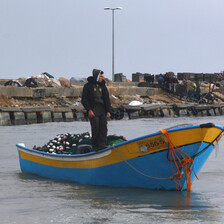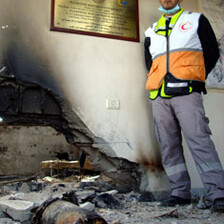Gaza Strip 16 January 2009

Where a family’s home once stood.
January 15, 2009, 11:02 am
When I’d met the extended Abed Rabu family, before the ground invasion began, they had just had their house bombed by an F-16. Their area has been occupied by Israeli tanks and soldiers since the ground invasion began. Medical workers cannot reach the injured there, and those who have managed to escape testify to imprisonment in their houses, abuse, point-blank shooting (to death), and a number of dead not yet known. It’s an area Israel views as strategic, lying just hundreds of meters from the eastern border to Israel, a key entry point for invading troops. Past invasions have meant entire families and neighbors being locked into a room of a house for a day or days. Supposition among journalists and those with two cents here is that Israel’s intense bombardment of, and destruction of houses in, the area is to both decimate any resistance and to create an alternate “road” for tanks and troops to roll in on, meaning houses in their path are leveled to the ground.
That day, Abu Mahmoud Abed Rabu had related the events of his house demolition. “A person called me saying he was a spokesperson for the Israeli army and that we had seven minutes to leave the house before it was bombed. I begged for 10, told him seven wasn’t enough to collect possessions and get our children out safely. He said seven,” Abed Rabu explained. His family made it out in time, avoiding the death sentence that has been given so many here, without warning.
He said he’d just stood away from the house and watched as it was bombed, watched 20 years of his life be erased, with everything inside it. “I’m just a working man, not Fatah, not Hamas. Just a man. Why did they bomb my house?” he asked. “There were four families in here, at least 25 children,” he added.

Cooking over burning wood.
We’d continued visiting sites of missile strikes around the Ezbet Abed Rabu area. A yard with two massive craters in it, one from that morning and one from the night before. Looking from a room at the back of a two story house, I noticed the damage the F-16 bombs had done not only to the land but also to the houses around. Glass shattered, window frames blown in, safety to the wind …
Bombing central Gaza
15 January 2009, 2:01pm
Now that people have streamed out of homes in all the perimeter regions of Gaza, they are streaming out of homes in central Gaza. I went briefly back to an apartment I’d been given by the Palestinian Centre for Human Rights (PCHR), to collect some things … and decided to collect anything I valued, infinitely luckier than the dead or those who are given but five minutes to run for their lives.
But people are running, and the small space that is the Gaza Strip has become a pinpoint, with people crammed into centers and still not feeling safe.
Leila in al-Quds hospital at 8:59 am: “So Al-Quds now has [Israeli] army outside. Snipers next door, 50 hits near us during night and four hits to us. Fire in apartments behind, wounded kids near who we can’t collect …”
Update:
The al-Quds hospital continues to be surrounded by invading Israeli troops, with snipers positioned in the high buildings around the hospital neighborhood. Doctors and those inside report being unable to leave the hospital.
The headquarters of the United Nations agency for Palestine refugees (UNRWA) was hit three times by tank shelling, injuring three UN workers. Around 700 Palestinians were seeking shelter in the compound, which is clearly marked as a UN compound.
Israeli forces targeted one of the media buildings housing numerous different stations. At least two journalists were injured in the tank shelling on the building.
And aside from reports on the targeting of key infrastructure here, let me just repeat, people are panicking, given that Gaza City is a central place, the hub of Gaza and where those already having fled Israeli army attacks from eastern and northern regions had hoped for safety. As we’ve said from the first day of Israel’s phenomenally brutal attacks on civilians, there’s still is not anywhere anyone can feel safe.
All images copyright Eva Bartlett.
Eva Bartlett is a Canadian human rights advocate and freelancer who spent eight months in 2007 living in West Bank communities and four months in Cairo and at the Rafah crossing. She is currently based in the Gaza Strip after having arrived with the third Free Gaza Movement boat in November. She has been working with the International Solidarity Movement in Gaza, accompanying ambulances while witnessing and documenting the ongoing Israeli air strikes and ground invasion of the Gaza Strip.
Related Links





